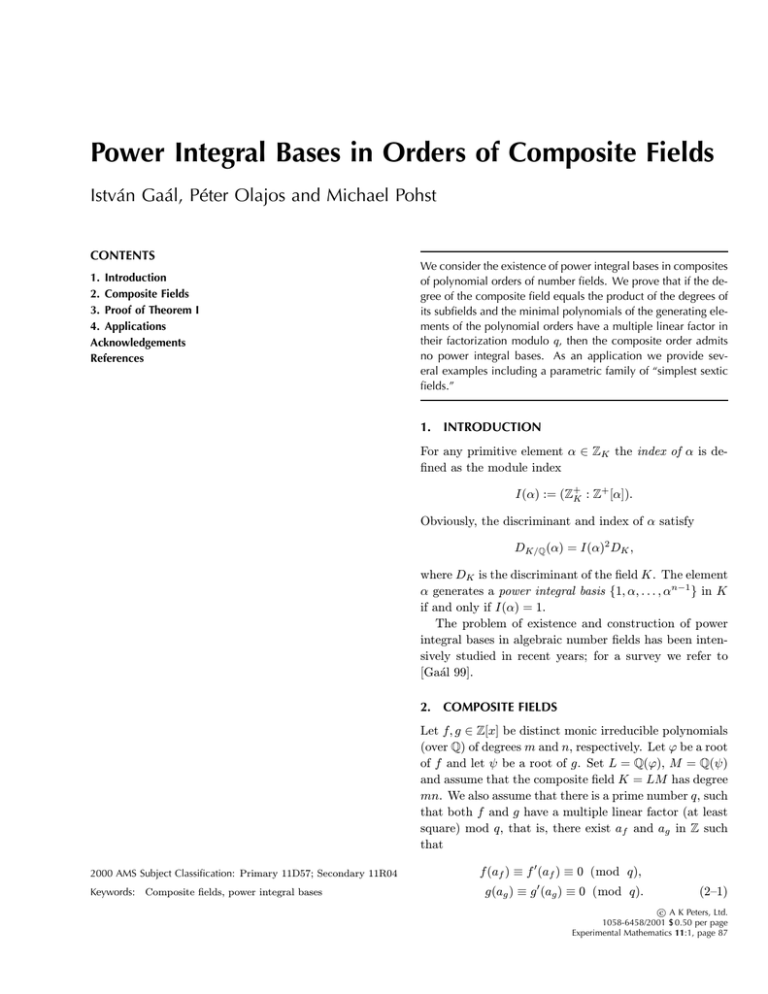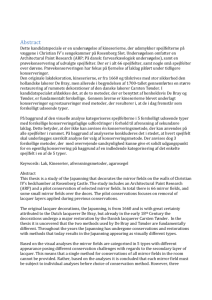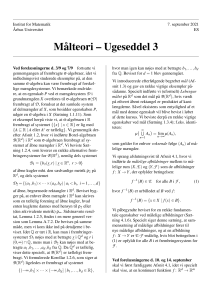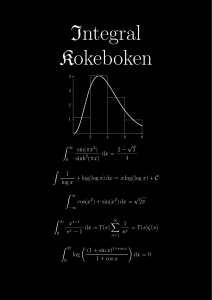Power Integral Bases in Orders of Composite Fields CONTENTS
advertisement

Power Integral Bases in Orders of Composite Fields
István Gaál, Péter Olajos and Michael Pohst
CONTENTS
1. Introduction
2. Composite Fields
3. Proof of Theorem I
4. Applications
Acknowledgements
References
We consider the existence of power integral bases in composites
of polynomial orders of number fields. We prove that if the degree of the composite field equals the product of the degrees of
its subfields and the minimal polynomials of the generating elements of the polynomial orders have a multiple linear factor in
their factorization modulo q, then the composite order admits
no power integral bases. As an application we provide several examples including a parametric family of “simplest sextic
fields.”
1. INTRODUCTION
For any primitive element α ∈ ZK the index of α is defined as the module index
+
I(α) := (Z+
K : Z [α]).
Obviously, the discriminant and index of α satisfy
DK/Q (α) = I(α)2 DK ,
where DK is the discriminant of the field K. The element
α generates a power integral basis {1, α, . . . , αn−1 } in K
if and only if I(α) = 1.
The problem of existence and construction of power
integral bases in algebraic number fields has been intensively studied in recent years; for a survey we refer to
[Gaál 99].
2. COMPOSITE FIELDS
Let f, g ∈ Z[x] be distinct monic irreducible polynomials
(over Q) of degrees m and n, respectively. Let ϕ be a root
of f and let ψ be a root of g. Set L = Q(ϕ), M = Q(ψ)
and assume that the composite field K = LM has degree
mn. We also assume that there is a prime number q, such
that both f and g have a multiple linear factor (at least
square) mod q, that is, there exist af and ag in Z such
that
2000 AMS Subject Classification: Primary 11D57; Secondary 11R04
Keywords:
Composite fields, power integral bases
f (af ) ≡ f 0 (af ) ≡ 0 (mod q),
g(ag ) ≡ g0 (ag ) ≡ 0 (mod q).
(2—1)
c A K Peters, Ltd.
°
1058-6458/2001 $ 0.50 per page
Experimental Mathematics 11:1, page 87
88
Experimental Mathematics, Vol. 11 (2002), No. 1
Remark 2.1. Our assumption implies that q divides both
the discriminant d(f ) of the polynomial f and the discriminant d(g) of g.
of the order Og , respectively. The discriminant of the
order Of g is
Remark 2.2. In [Gaál 98] we considered fields that are
composites of subfields with coprime discriminants. According to the remark above in our case the fields we
consider are composites of subfields whose discriminants
are not coprime. This is the case in many interesting
examples some of which we list at the end of the paper.
We can represent any element α ∈ Of g in the form
Consider the order Of = Z[ϕ] of the field L, the order
Og = Z[ψ] of the field M and the composite order Of g =
Of Og = Z[ϕ, ψ] in the composite field K = M L. Note
that {1, ϕ, . . . , ϕm−1 }, {1, ψ, . . . , ψ n−1 } and
{1, ϕ, . . . , ϕm−1 , ψ, ϕψ, . . . , ϕm−1 ψ,
. . . , ψ n−1 , ϕψ n−1 , . . . , ϕm−1 ψ n−1 },
are Z-bases of Of , Og and Of g , respectively.
Our main result is the following:
Proposition 2.3. Under the assumptions above the index
of any primitive element of the order Of g is divisible by q.
As a consequence we have:
Proposition 2.4. Under the assumptions above the order
Of g has no power integral bases.
At the end of the paper we give several applications
of the propositions.
Note that a similar phenomenon occurs for composite
fields in other cases as well, cf. [Gaál 95], [Gaál 98], [Gaál
00].
3. PROOF OF PROPOSITION 1
Denote the conjugates of ϕ ∈ L by ϕ(i) (1 ≤ i ≤ m)
and the conjugates of ψ ∈ M by ψ (j) (1 ≤ j ≤ n).
Denote by γ (i,j) the conjugate of any element γ ∈ K
under the automorphism mapping ϕ to ϕ(i) and ψ to
ψ (j) (1 ≤ i ≤ m, 1 ≤ j ≤ n).
The discriminants of the polynomials f and g are
Y
d(f ) =
(ϕ(i) − ϕ(j) )2
1≤i<j≤m
d(g) =
Y
1≤i<j≤n
(ψ (i) − ψ (j) )2 .
(3—1)
These are also the discriminants of the bases
{1, ϕ, . . . , ϕm−1 } of the order Of and {1, ψ, . . . , ψ n−1 }
D(Of g ) = d(f )n · d(g)m .
α=
m−1
X n−1
X
xij ϕi ψ j
(3—2)
(3—3)
i=0 j=0
with xij ∈ Z. The index of α (generating K over Q)
corresponding to the order Ofg is defined to be the Zmodule index of Z[α] in Of g . It is
¯
¯
Y
1
¯ (i1 ,j1 )
¯
IOf g (α) = p
− α(i2 ,j2 ) ¯
¯α
|D(Of g )| (i ,j )<(i ,j )
1
1
2
2
where the pairs of indices are ordered lexicographically.
Now we rearrange the factors in the product above. Using
(3—1) and (3—2) we have
¯ (i,j )
¯
m
Y
Y
¯ α 1 − α(i,j2 ) ¯
¯
¯
IOf g (α) =
¯ ψ (j1 ) − ψ (j2 ) ¯
i=1 1≤j1 <j2 ≤n
¯ (i ,j)
¯
n
Y
Y
¯ α 1 − α(i2 ,j) ¯
¯
¯
×
¯ ϕ(i1 ) − ϕ(i2 ) ¯
j=1 1≤i1 <i2 ≤m
¯
¯
Y
¯ (i1 ,j1 )
¯
− α(i2 ,j2 ) ¯ .
×
¯α
(i1 , j1 ) < (i2 , j2 )
i1 6= i2
j1 6= j2
(3—4)
Obviously, the factors that appear in (3—4) are algebraic
integers.
For any 1 ≤ i1 < i2 ≤ m and 1 ≤ j1 < j2 ≤ n we have
³
´ ³
´
α(i1 ,j1 ) − α(i2 ,j1 ) + α(i2 ,j1 ) − α(i2 ,j2 )
´
³
+ α(i2 ,j2 ) − α(i1 ,j1 ) = 0
which implies the equation
´
³
´
³
ϕ(i1 ) − ϕ(i2 ) ε + ψ (j1 ) − ψ (j2 ) η + ρ = 0
(3—5)
with
α(i1 ,j1 ) − α(i2 ,j1 )
,
ϕ(i1 ) − ϕ(i2 )
α(i2 ,j1 ) − α(i2 ,j2 )
,
η=
ψ (j1 ) − ψ (j2 )
ε=
ρ = α(i2 ,j2 ) − α(i1 ,j1 ) .
Since these elements are factors in (3—4) they are algebraic integers lying in the Z-order O = Oi1 ,i2 ,j1 ,j2 =
Z[ϕ(i1 ) , ϕ(i2 ) , ψ (j1 ) , ψ (j2 ) ].
Gaál et al.: Power Integral Bases in Orders of Composite Fields
Let us fix those indices 1 ≤ i1 < i2 ≤ m and 1 ≤
j1 < j2 ≤ n for which ϕ(i1 ) ≡ ϕ(i2 ) (mod q) and
also ψ (j1 ) ≡ ψ (j2 ) (mod q). Consider equation (3—5)
modulo q.
By our assumptions ϕ(i1 ) − ϕ(i2 ) ≡ 0 (mod q) and
(j1 )
ψ
− ψ (j2 ) ≡ 0 (mod q), hence by equation (3—5) we
get ρ = α(i2 ,j2 ) − α(i1 ,j1 ) ≡ 0 (mod q). This is one of
the algebraic integer factors of I(α), hence q|I(α).
4. APPLICATIONS
4.1 A Cyclic Sextic Field
Consider the sextic field K generated by a root of h(x) =
x6 − x5 − 6x4 + 6x3 + 8x2 − 8x + 1. This is a totally
real cyclic sextic field with discriminant DK = 453789 =
33 75 . Its cubic subfield is L = Q(ϕ) (with discriminant
49) where ϕ is a root of f (x) = x3 + 4x2 + 3x − 1. In the
field L the elements {1, ϕ, ϕ2 } form an integral basis. We
3
subfield
have f (x) ≡
√ (x + 6) (mod 7). The quadratic
is M = Q(√ 21). The polynomial g(x) = x2 − x − 5 has
ψ = (1 + 21)/2 as a root, and obviously {1, ψ} is an
integral basis in M . We have g(x) ≡ (x − 1/2)2 (mod
7). Proposition 1 implies that the indices of the primitive
elements of the order Of g = Z[1, ϕ, ϕ2 , ψ, ϕψ, ϕ2 ψ] are all
divisible by 7, hence it has no power integral basis.
4.2 A Non-Cyclic Sextic Field
Consider the sextic field K generated by a root of
h(x) = x6 − 12190x4 + 256565x2 − 12167. This is a totally real sextic field with Galois group D6 , discriminant
DK = 26 172 233 6472 . Its cubic subfield is L = Q(ϕ) (with
discriminant 252977 = 17 · 23 · 647 and Galois group S3 )
where ϕ is a root of f (x) = x3 − 22x2 − 23x − 1. In the
field L the elements {1, ϕ, ϕ2 } form an integral basis. We
have f (x) ≡ (x+15)(x+
16)2 ( mod 23). The quadratic
√
2
subfield is
√ M = Q( 23). The polynomial g(x) = x − 23
has ψ = 23 as a root, and obviously {1, ψ} is an integral
basis in M . We have g(x) ≡ x2 (mod 23). Proposition
1 implies that the indices of the primitive elements of
the order Of g = Z[1, ϕ, ϕ2 , ψ, ϕψ, ϕ2 ψ] are all divisible
by 23, hence it has no power integral basis.
This family of fields is called the “simplest sextic fields”.
It has some attractive properties which are listed in [Lettl
et al. 98]. These fields are totally real cyclic fields. Let p
be a prime dividing q = t2 +3t+9. We have d(ht ) = 66 q 5 .
Note that ht (x) ≡ (x − t/3)6 (mod p) (the “simplest
quintic fields” have a similar property, cf. [Gaál and
Pohst 97]).
The cubic subfield Lt of Kt is generated by a root ϕ
of ft = x3 − tx2 − (t + 3)x − 1 with d(ft ) = q 2 . These are
the “simplest cubic fields”, totally real, cyclic. It is well
known that {1, ϕ, ϕ2 } is an integral basis of Z[ϕ]. Note
that ft (x) ≡ (x − t/3)3 (mod p).
√
The quadratic subfield of Kt is Mt = Q( q) .
If q ≡ 2, 3 (mod 4) then set gt (x) = x2 − q with
√
d(gt ) = 4q and with a root ψ = q. In this case
gt (x) ≡ x2 (mod p).
If q ≡ 1 (mod 4) then set gt (x) = x2 − x − (q − 1)/4
√
with d(gt ) = q and with a root ψ = (1 + q)/2. In this
2
case gt (x) ≡ (x − 1/2) (mod p).
In both cases {1, ψ} is an integral basis of Mt .
Consider now the order Of g = Z[1, ϕ, ϕ2 , ψ, ϕψ, ϕ2 ψ].
By Proposition 1 the indices of the primitive elements
of Of g are all divisible by p, hence Of g has no power
integral bases.
4.4 A Field of Higher Degree
This is an example to illustrate that our results are easily
applicable also to suitable fields of higher degrees.
Let ϕ be a root of f (x) = x5 − 2x4 + 7x2 + 6x + 5.
The quintic field L = Q(ϕ) has no non-trivial subfields.
Let ψ be a root of g(x) = x8 + 13x7 + 55x6 + 75x5 +
2x3 − x2 − 143x − 525. The octic field M = Q(ψ) has no
non-trivial subfields, either. We have
f (x) ≡ (x + 16)2 (x3 + 16x + 5) (mod 17)
g(x) ≡ (x + 5)2 (x3 + 12x2 + 2x + 14)
× (x3 + 8x2 + 4x + 7) (mod 17)
hence our Proposition 1 applies. Consider the order
Of g = Z[ϕ, ψ] of the field K = Q(ϕ, ψ) of degree 40.
Any α ∈ Of g can be represented in the form
4.3 The Parametric Family of Simplest Sextic Fields
Assume 3 - t, t 6= −8, ±5. Let us consider the family of
sextic fields Kt generated by a root β of the polynomial
ht (x) = x6 − 2tx5 − (5t + 15)x4 − 20x3
+ 5tx2 + (2t + 6)x + 1.
89
α=
7
4 X
X
xij ϕi ψ j
i=0 j=0
with xij ∈ Z. By Proposition 1 the indices of all primitive
elements of Of g are divisible by 17, hence Ofg admits no
power integral bases.
90
Experimental Mathematics, Vol. 11 (2002), No. 1
ACKNOWLEDGEMENTS
The research of István Gaál was supported in part by Grants
T 29330 and T 037367 from the Hungarian National Foundation for Scientific Research and by FKFP 0343/2000. The
research of Péter Olajos was supported by FKFP 0343/2000.
REFERENCES
[Gaál 95] I.Gaál. “Computing elements of given index in totally complex cyclic sextic fields.” J. Symbolic Computation 20 (1995), 61—69.
[Gaál 98] I.Gaál. “Power integral bases in composits of number fields.” Canad. Math. Bulletin 41 (1998), 158—165.
[Gaál 99] I.Gaál. “Power integral bases in algebraic number
fields.” Annales Univ. Sci. Budapest., Sect. Comp. 18
(1999), 61—87.
[Gaál 00] I.Gaál. “Solving index form equations in fields of
degree nine with cubic subfields.” J. Symbolic Comput.
30 (2000), 181—193.
[Gaál and Pohst 97] I.Gaál and M.Pohst. “Power integral
bases in a parametric family of totally real quintics.”
Math. Comp. 66 (1997), 1689—1696.
[Lettl et al. 98] G.Lettl, A.Pethő, P.Voutier. “On the arithmetic of simplest sextic fields and related Thue equations.” In Number Theory, eds. K.Győry, A.Pethő,
V.T.Sós, pp. 331—348, Walter de Gruyter, Berlin-New
York, 1998.
István Gaál, University of Debrecen, Mathematical Institute H-4010 Debrecen Pf.12., Hungary (igaal@math.klte.hu)
Péter Olajos, University of Debrecen, Mathematical Institute H-4010 Debrecen Pf.12., Hungary (olaj@math.klte.hu)
Michael Pohst, Technische Universität Berlin, Fakultät II, Institut für Mathematik, Strasse des 17. Juni 136,
Berlin 10623, Germany (pohst@math.tu-berlin.de)
Received February 28, 2001; accepted in revised form August 14, 2001.







